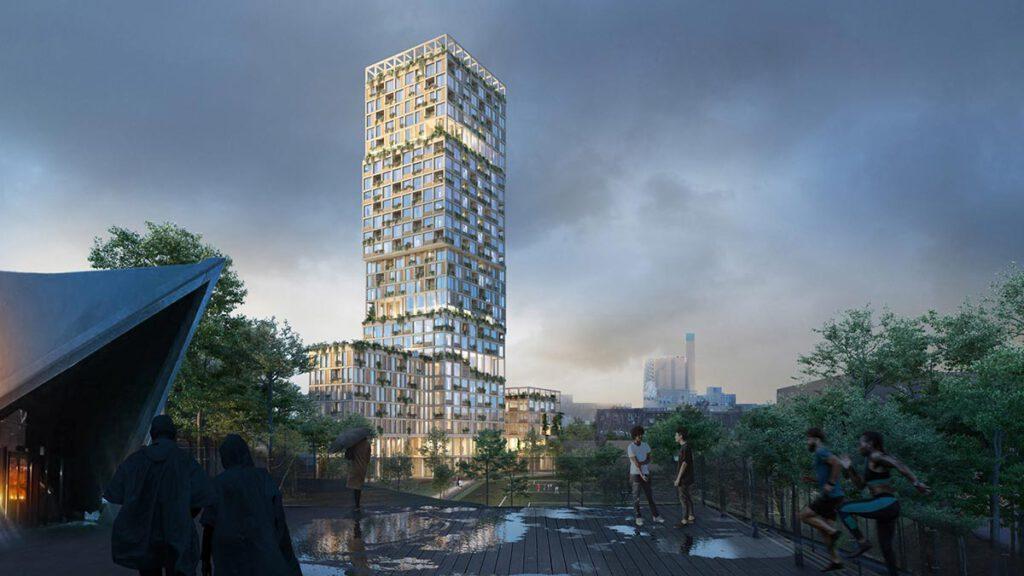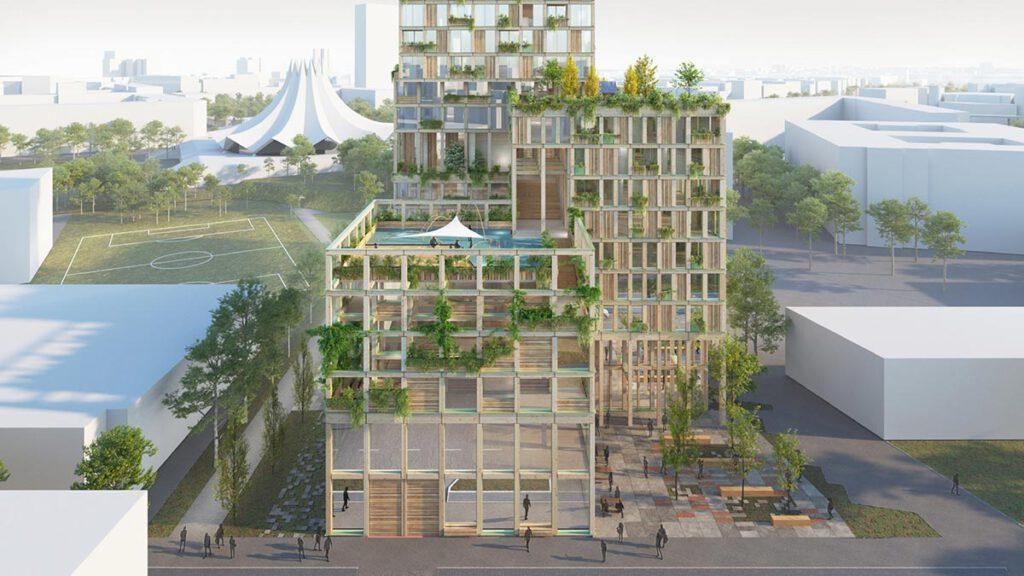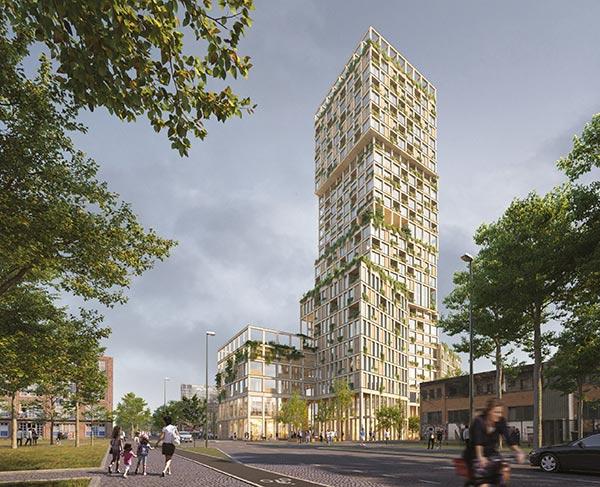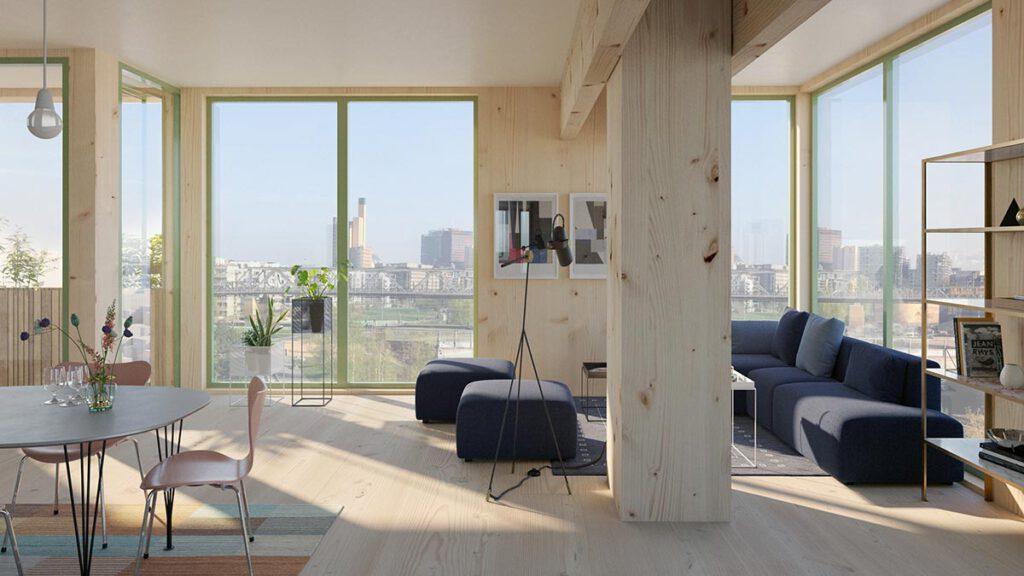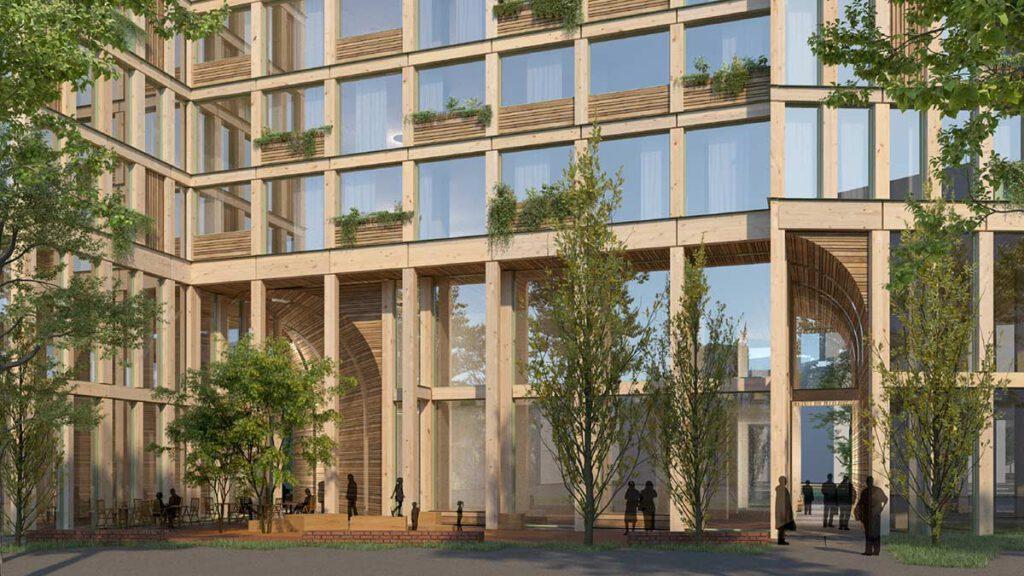New Kiez on the Block
An entire residential complex in Berlin-Kreuzberg is to be built out of timber – vertically. With a planned height of almost 100 metres, WoHo is set to be Germany’s tallest timber building.
Kreuzberg is a vibrant Kiez (district) in Berlin with cosy cafés, vintage stores, cultural diversity and one of the highest number of bars per square metre in the world. Norwegian architectural firm Mad Arkitekter has taken a typical Kreuzberg residential complex in all its diversity and turned it on its end. The result is a residential tower – known as WoHo (short for Wohnhochhaus) – built primarily of timber. At a height of 98 metres (322 ft), it will have a good 13 metres (43 ft) on the current world record holder, Mjøstårnet in the Norwegian town of Brumunddal.
However, the competition in high-rise timber construction never sleeps and the limits of feasibility are being pushed higher and higher. The “Dutch Mountains” flagship project in Eindhoven plans to scale even greater heights than in Berlin, establishing a 130-metre landmark with two unequal towers. But for the time being, WoHo can be sure of one title: it will be Germany’s highest timber residential building.
Reflecting the local mix
The 29-storey building will be located near Potsdamer Platz, right next to the Anhalter Bahnhof suburban train station. Here, on a total floor space of 18,000 square metres (almost 60,000 ft), people will be living and working in four different cubages in future. 60% of the mixed use project will be devoted to residential space, 25% to commercial space and 15% to social infrastructure such as a co-making workshop, kindergartens and common spaces.
Our concept is a vertical interpretation of a typical Kreuzberg block. In many respects, WoHo is a city unto itself.
Jonny Klokk, architect
This corresponds to the average use of space in the new building’s neighbourhood. As the architects explain: “In many respects, WoHo is a city unto itself. Our concept is a vertical interpretation of a typical Kreuzberg block. The diverse composition of building structures of varying heights and widths reflects the scale of the city and the diversity of the neighbourhood and its people.”
A rooftop garden for all
Between the structures of varying sizes, the building will integrate small plazas and lush green areas, both of which will be freely available to the public. The interior of the building – such as the open ground floor and external staircase leading to the upper storeys – is also to be accessible to the public.
In short, WoHo wants to open up to the outside world, just like the neighbourhood blocks on a horizontal level. The timber building also gives Berlin locals added value in the form of a spectacular view of the whole city. Up on high, the rooftop garden will treat its visitors to an extensive view in all directions. Describing what he and his Mad Arkitekter colleagues were aiming to achieve, Jonny Klokk says: “We hope that, with all it has to offer local people, WoHo will prove to be a popular meeting place for all of Kreuzberg.”
Timber hybrid high-rise
WoHo is to be built in a timber hybrid style. While the staircases and elevator shafts of the four structures will be built using steel and concrete, the rest of the supporting construction will be made of wood.
As a sustainable building material, timber is now well established in international urban planning circles. In many cases, building regulations still pose initial difficulties as they are geared towards conventional construction. There are still many reservations regarding multi-storey timber buildings, particularly when it comes to fire protection.
Wood boasts better fire properties
However, this is not a view that is shared by the experts. While a steel girder might give way unexpectedly in the heat of a fire, wood burns in a more controlled way. There is a protective layer of charcoal on the surface of the wood, which provides enormous resistance.
Timber is a material with smart properties that prove their worth above all in new buildings.
Jonny Klokk, architect
This property has been harnessed in Japan for thousands of years. Shou sugi ban is a method for sealing wood by carbonizing the surface. This kind of wood panelling only needs to be maintained every 100 years and also provides effective protection against fire.
Building material of the future
For the WoHo architects, timber is the building material of the future. Besides exuding warmth and being pleasant to the touch, the major advantage of this renewable raw material is its ability to store carbon dioxide.
Jonny Klokk: “Timber has a smaller carbon footprint than most conventional building materials – it has smart properties that prove their worth above all in new buildings. Wood is important for the future of our planet as a means of countering the high energy and resource consumption in the construction industry.”
Text: Gertraud Gerst
Translation: Rosemary Bridger-Lippe
Renderings: Mad Arkitekter
